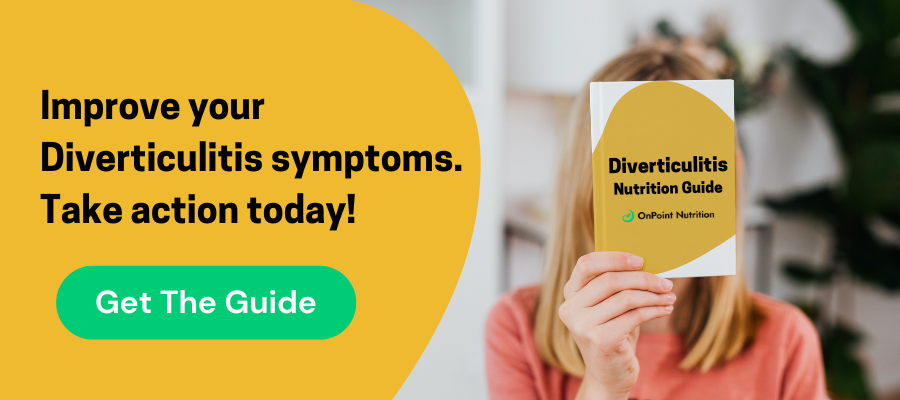
Not all cases of Diverticulitis are the same, thus the treatment plan should not be the same. That’s where we come in! OnPoint’s approach to Diverticulitis treatment and management is science-based and tailored to each individual case. You could be one of hundreds of clients that have allowed us to help them achieve long-term relief from Diverticulitis symptoms.
Here is the full rundown of how we work to help our clients manage their Diverticulitis.
Step 1: Assessment
Diverticular disease has two phases, the active phase (Diverticulitis) and the dormant phase (diverticulosis). Research suggests dietary changes are the key to preventing and treating Diverticulitis). To determine the best treatment approach, we must first determine what phase you condition is in and what dietary changes need to be made.
Diverticulosis and Diverticulitis Diet Basics
Diverticulosis Diet
The Diverticulosis diet is aimed to prevent a Diverticulitis flare. Although the direct cause of Diverticulitis is unknown, it is thought that constipation and increased pressure within the colon have a direct impact. Therefore, a high fiber diet rich in the foods listed below is the key to prevention.
- Fruits: Raspberries, pears, apples, bananas, oranges, strawberries
- Vegetables: Peas, broccoli, dark leafy greens, brussels sprouts, potatoes, corn, cauliflower, carrots
- Whole Grains: Whole wheat pasta, barley, quinoa, brown rice, oatmeal, popcorn, whole grain bread
- Beans & Legumes: Split peas, lentils, black beans, kidney beans, chickpeas
Diverticulitis Diet
If you find yourself in a Diverticulitis flare, your doctor may recommend temporary dietary restrictions to allow the colon to rest and clear the infection. The most common recommendation is a liquid diet. The liquid diet includes all liquids and liquid-like food products and should only be followed for 2-3 days or until symptoms improve.
- Liquids: Water, electrolyte drinks, juice, broth, tea, coffee
- Liquid-like foods: Jell-O, hard candy, popsicles, ice chips
Following the liquid diet, you may be instructed to begin adding bland, low fat foods and liberalizing as symptoms improve.
Step 2: Program Personalization
After determining the best treatment plan for you, our dietitians will create personalized materials to help get you started and guide you on your health journey. When it comes to Diverticulosis, our team focuses on a few different diet and lifestyle improvements to help manage your condition long term and prevent future Diverticulitis flares:
- High Fiber Diet: Your nutritionist or dietitian will calculate your energy and macronutrient needs to determine the optimal food intake for you. The quality of your food will be a large topic of conversation to ensure that the calories and macronutrients that you are eating are high in fiber to support healthy bowel function.
- Regular Exercise: Exercise promotes regular bowel movements and can help to reduce pressure inside your colon. We will work with you to determine the right exercise plan for your lifestyle and abilities.
- Hydration: Fiber’s function is to absorb water and increase bulk in your stool to allow it to pass through the colon more efficiently. However, it’s important to replace the fluid that is being utilized in the colon to ensure proper hydration is maintained. We will help you determine how much water you should be drinking in a day to support healthy bowel function.
Step 3: Monitor outcomes
We know that consistency and sustainability are the key to achieving long-term results. Throughout your program, your nutritionist or dietitian will monitor your progress to ensure that your program is serving you well. We will be on the lookout for changes in symptoms and opportunities to further customize your experience to fit your lifestyle. These outcome measures help us determine the best plan to provide you with long-term symptom relief, complication prevention, and increased quality of life!
For more information on how to manage a diverticulitis flare and improve your diet to deal with your diverticulitis, download our Diverticulitis Nutrition Guide.
Topics

Kaitlyn Willwerth is a Registered Dietitian at OnPoint Nutrition. Kaitlyn's work focuses on providing individualized health and lifestyle coaching and, most importantly, support. She is a Certified LEAP Therapist and has also completed the Monash University 'Low FODMAP Diet for IBS' online training course for health professionals.




